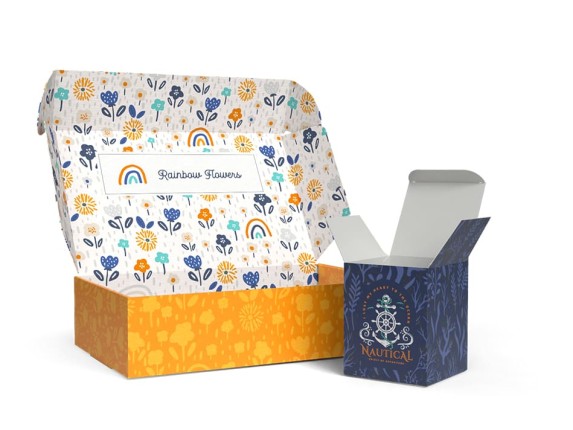Folding boxes
Folding boxes
Folding boxes from Labelprint24.com are high-quality, stable and flexibly applicable packaging that optimally present your products as brand ambassadors at the POS and also convince during shipping!
- Cardboard in white, coloured, natural, bright white & recycled
- Finishing with foil stamping, varnish etc.
- Grammages from 215 - 500 g/m²
Discover the wide range of folding boxes from Labelprint24.com!
- Production TimeStarting from 3 days
- MaterialGC2 / GC1 / GD2
- Size100% customizable
- OptionFinishing / Window
Select kind of product
Many finishes available for all box types
We offer many different finishes such as hot foil stamping, protective laminate or UV varnishing for your folding boxes. Many finishes not only serve a beautiful look, but also have a protective property. This turns your folding boxes into real highlights that impress with high quality and good looks. Thanks to various finishing techniques, such as hot foil stamping, you can design your folding boxes completely individually.
For example, the high-quality printed cosmetics box shown in the picture with noble golden hot foil stamping, which makes the folding box a real eye-catcher. In this way, thanks to refined folding boxes from Labelprint24, you can create a very special product presentation with your printed packaging.
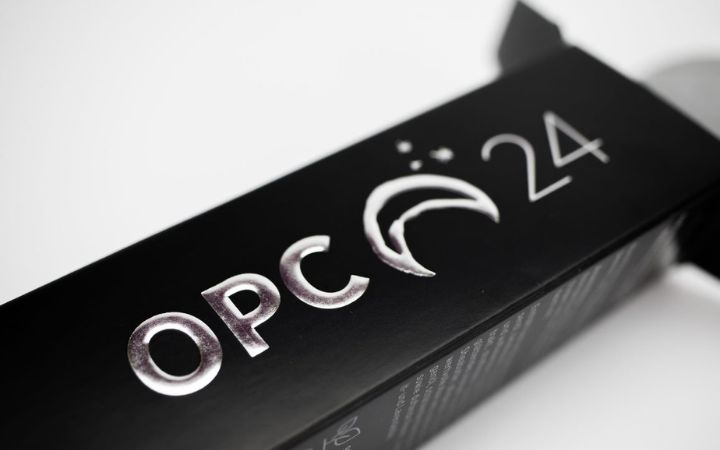
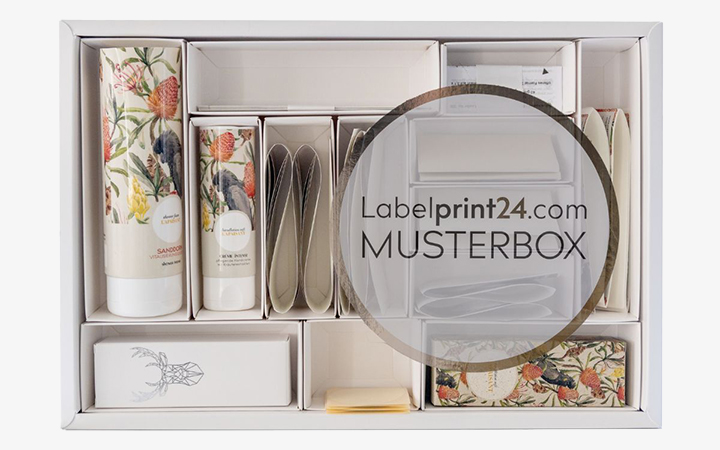
Sample made to measure.
Simply order online.
The sample box from Labelprint24 offers you an exclusive selection of products, printed and finished in our company design. We will refund the full purchase price of the sample box in the form of a voucher if you decide to order from Labelprint24. The voucher is of course valid for all products in our webshop.
In this box you will find samples of labels, folding boxes, laminate tubes and package inserts.
Your folding box printed by Labelprint24
- All sectors and industries
- Folding boxes for your specific requirements
- Standard sizes + any other size/format imaginable
- online calculator with instant price
- fast delivery times
By the way: This is how you create your print data for folding boxes correctly.
Customised boxes by Labelprint24
- Folding boxes: materials and manufacturing process
- Folding carton types
- Cartons with slip-on lids & hinged-lid boxes
- Standard formats: determining the right carton size
1. Folding boxes: materials and manufacturing process
Printed folding boxes serve as an individual advertising medium and also identify the content inside the box. Printable large and small folding cartons are used everywhere (industry, trade, commerce). Each folding carton is unique in form and function. Folding boxes are mainly made of paper materials such as solid, flat, or corrugated board. Depending on the application, different materials may be suitable.
- Secondary fibres: chromo duplex (GD, GD2) chromo triplex (GT1, GT2)
- Primary fibres: chromo sulphate (CS), chromo board (GC1, GC2)
- B-flute (fine fluting)
- C-flute (medium fluting)
- E-flute (micro fluting)
- F-flute (micro fluting)
Occasionally, plastics (PE, PET, PP) and tinplate are also used in the production of folding boxes. Composite materials made of polyethylene and aluminium are also used. Packaging trends such as individualisation and transparent product presentation are driving this development. The demand for window punching and other effects allowing customers to see through the package is also growing.
The functions of a folding box:
- Protection: it protects the contents from external influences such as dust, moisture, light, or scratches.
- Transport: it serves as space-saving, stackable packaging for the movement and storage of goods.
- Marketing: it can be readily stacked and presented on the store shelf. The surface can contain information and advertising and carry labels.
Chromo duplex board:
The front is wood-free and painted white; the inside and reverse are grey. Chromo duplex board has a very high proportion of waste paper. It is easy to fold this board and add grooves and notches. Chromo duplex board is particularly suitable as a material for folding cartons, inserts, and blister packs of all kinds.
Chromo triplex board:
Chromo triplex board is at least three-ply and has a coated secondary fibre board with grey inlay. Its reverse side can be white, light, or brown. This board is often used for folding cartons, displays, and packaging.
Chromosulphate board:
Chromosulphate board, also known as chromosulphate paper, is popular for high-quality printed matter. This board takes well to processing and has a different look and feel from other carton boxes. Chromosulphate board is very stable, coated on one side, and has a very high white content. The coating makes it possible to print very precisely on the top side. The reverse side of the board, which has rather open pores, is also good for printing. This board can be folded, grooved, embossed, and punched. It is very stable and not necessarily stiff. This carton is particularly suitable for all products that are frequently opened and closed, since the notches will not break out. It also takes well to refinement with a number of different coatings.
Chromo board:
Chromo board is a multi-layer board made of waste paper or wood dust with a coated, flat surface. In general, chromo board has a very high strength for paper material and is often used instead of corrugated board, solid board, or other fine carton. Plastic boxes are less affordable, have a higher environmental impact, and are more difficult to recycle.
How folding cartons are manufactured
Making a box foldable
Basically, all folding cartons must be punched, with grooves, fold lines, and notched. To ensure that the folding carton can be readily folded, the printed sheet must be scored with fold lines. These are pressed into the material so that the carton can later be folded over without tearing.
Scribing the carton
The outside of the board is scribed, partly cut without going all the way through, to allow flaps or openings to be punched out later by the customer. Finally, the punched carton blanks are broken out and fed into a folding carton gluing machine.
Punching contours
The printed and finished sheets are then fed into a flatbed die cutter. The contours of the carton are punched out with the aid of a punching die made of a razor-sharp material, usually a finely honed steel strip. By pressing the sharp-edged punching tool into the board, the paper fibres are cleanly separated from each other. In general, paper, carton, and corrugated board can be punched. When producing a generic folding carton (without imprint), punching is the first processing step. The right cutting die for every folding carton can always be ordered to measure in our folding carton calculator from labelprint24.
Gluing and shipping of boxes
Since the majority of the folding cartons produced have to be assembled with an insert or auto bottom in machine packaging systems, it is necessary that they can be opened precisely, reliably and easily. First, the creases are made soft and supple. In the final step, the punched-out box blanks are glued at points along the longitudinal seam or on the side parts. The finished folding cartons are then folded and sent to the customer.
Production process from order acceptance to dispatch to the customer
1.1 The pre-print stage
1.2 The actual printing process
1.3 Digital printing of cartons
Affordable custom cartons: digital printing makes it possible
Digital printing of made-to-measure folding cartons is not limited to the actual printing process, but also includes the ordering process and digital further processing and finishing. Digital is related to the word "digit" and involves binary, machine-readable data. The entire digital production process of folding cartons and shipping boxes is based on the processing of data. This print data can be read directly by computers using software, processed, then passed on to other devices in the production process, such as a KAMA or laser punch.
This type of data processing offers enormous time and cost advantages for the production of folding cartons since printing plates and mechanical cutting dies are no longer required. Carton costs are generally influenced by a number of factors: the print run, the dimensions, the printing involved, the material, and the construction. All of these factors can be adjusted to allow for bespoke packaging for each and every product that needs to be packaged.
1.4 Offset printing of boxes
1.5 Flexographic printing
The inks used for flexo printing are mostly environmentally friendly, thin liquids. Depending on the materials being printed, different low-viscosity inks are used. The printing inks are either UV-curing, water-based, or solvent-based inks.
1.6 Screen printing
The fineness of the mesh is selected depending on the properties of the fabric being printed, the detail in the print motif, the size of the ink pigments, and the desired ink application. In screen printing, there is no standard mesh. Its fineness is measured either in grids per inch or threads per centimetre.
1.7 Intaglio printing
How does intaglio printing work?
What kinds of things are printed with intaglio printing?
Characteristics of intaglio printing
1.8 Hybrid printing of boxes
1.9 Letterpress printing of packaging
1.10 Coatings
1.11 Print finishing
1.12 Why are finishes so important?
Since the 1990s, the requirements for packaging materials have again changed. As consumers' environmental awareness has grown, attention has turned to questions of disposal and recycling. More information has to be displayed on the cartons's surface and packaging that is easier for an ageing population to open and close has also become important. Folding boxes can only do justice to this variety of functions with product design and finishing opportunities.
1.13 Which finishes are available?
1.13.1 Laminating
1.13.2 Protective laminate
1.13.3 Hot foil stamping
1.13.4 Cold foil stamping
1.13.5 Dispersion coating
1.13.6 UV coating
1.13.7 Blind embossing
1.13.8 Form punching
2. Folding carton types
- Rectangular folding carton with longitudinal seam gluing,
- Rectangular folding carton without longitudinal seam gluing,
- Folding carton not rectangular with longitudinal seam gluing,
- Folding carton not rectangular without longitudinal seam gluing,
- Folding carton with product integration and
- Other folding cartons
2.1 Folding cartons with tuck-in flap
.png)
The production of folding cartons with tuck-in flaps begins with the printing of the paperboard sheets. The printed paperboard sheets can then be refined in a variety of ways. The most common finishes include embossing and perforating, laminating and coating, or adding other materials such as plastic or metal foils. After printing and finishing, the blanks are cut from the printed sheets and the folds are grooved. After it is punched out, the body of the carton is provided with adhesive dots at the adhesive flap and glued together. This type of bonding is called side seam or longitudinal seam gluing. Side seam gluing is done at high speed on an automatic gluing machine.
The carton surface can be printed with any colour motif on any outside or even inside wall. This extensive printing area can be used for advertising purposes or to provide information about the manufacturer, dosage, detailed ingredients, etc.
Folding cartons with tuck-in flaps are usually made of a solid paperboard. The solid board maintains the box shape when filled and protects the contents during transport and storage. Paperboard is easy to print, easy to fold and, above all, recyclable.
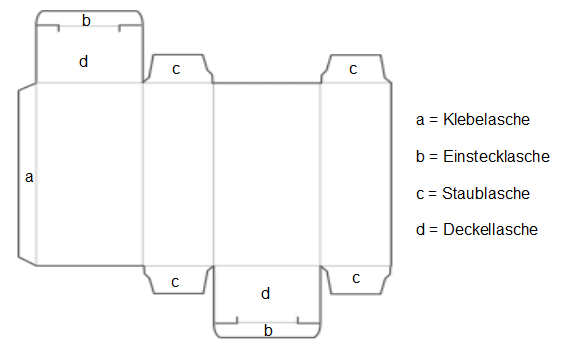
The folding carton with tuck-in flaps is the most widely used and inexpensive type of printed folding carton. On both its lid and base, it has two lateral dust flaps and a tuck-in flap that closes with friction. However, the flaps themselves do not provide a secure seal for the box. The tuck-in flap can also be equipped with locking slots or a closing tongue to guarantee a more secure hold on the lid. These boxes are often used for medicines, software, cosmetics, tubes of all kinds, and small bottles.
2.2 Folding cartons with reverse tuck end
.png) In industrial packaging,folding cartons with reverse tuck ends are mainly used to package products requiring a stable bottom due to their weight. The reverse tuck end prevents the contents from slipping downwards.
In industrial packaging,folding cartons with reverse tuck ends are mainly used to package products requiring a stable bottom due to their weight. The reverse tuck end prevents the contents from slipping downwards.Typical applications include cases of glass bottles, secondary packaging, cosmetics in glass containers, colognes, ceramics, and beverage cans. Whenever a "normal" tuck-in flap does not close the base firmly enough and the product could slip through it, folding cartons with an reverse tuck end are the safer alternative. The packaged goods press down on the interlocking tuck-in flaps and thus strengthen the stability of the bottom. The reverse tuck end also ensures that the folding cartons are stable. Unlike auto-bottom boxes, boxes with reverse tuck ends do not automatically set up when filled.
All six sides offer space for information and advertising. The invisible parts of the reverse tuck end are cut away during printing.
The folding carton with reverse tuck end also fulfils several functions simultaneously for the product inside it. It protects the contents from external influences such as dust, moisture, light, or scratches. It serves as transport packaging and ensures that the products can be easily stacked and presented on the shelves. The surface can contain information and advertising or hold secondary packaging, such as labels. Folding cartons and their contents almost always form a product unit and consumers perceive them as such.
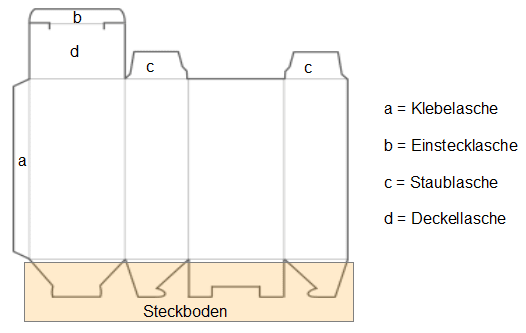
The folding carton with reverse tuck end is a special form of the box with tuck-in flaps. The reverse tuck end consists of one flap on each of the four sides of the bottom opening. When assembled, the flaps fold inwards and hook into each other. They lock each other in place and thus prevent the contents of the packaging from falling out.
2.3 Folding cartons with auto bottom
.png)
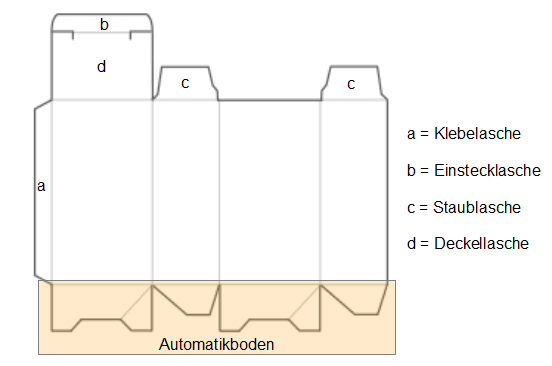
Folding cartons with automatic bottoms are another special form of cartons with tuck-in flaps. The auto bottom is glued during production and is therefore extremely stable. Filling these cartons is especially quick and easy, since the bottom automatically assembles when filled.
2.4 Folding cartons with tuck-in flap and Euro slot hanger
.png)
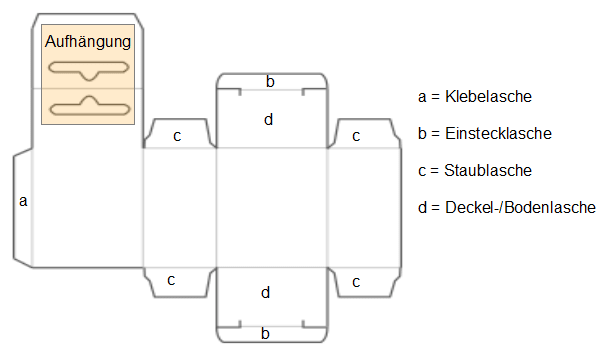
The folding carton with tuck-in flap and Euro slot hanger has a stable additional tab in the lid with a punched out slot for hanging. This makes the boxes easy to display for self service at supermarkets, electronics stores, or DIY stores. Hanging boxes are typically used to package ink cartridges, metal goods, small electronic devices, or toys. The stability of the lid and bottom vary depending on the weight of the contents and can use tuck-in flaps, an auto bottom, or locking slots and tongues.
2.5 Pillow boxes
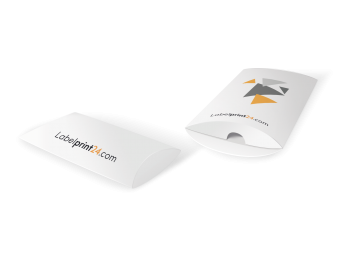 Pillow boxes with their eye-catching, curved shape are aesthetically pleasing while optimally protecting their contents. Pillow boxes are inexpensive to produce and easy to open and close again. Pillow boxes are ideal for packaging T-shirts, promotional items, giveaways, and gifts. Setting up a pillow box is particularly easy and very fast. The printed and unprinted pillow box can also be produced open on one side (without closure). This is popularly used for sandwiches, mini pizzas, burritos, etc.
Pillow boxes with their eye-catching, curved shape are aesthetically pleasing while optimally protecting their contents. Pillow boxes are inexpensive to produce and easy to open and close again. Pillow boxes are ideal for packaging T-shirts, promotional items, giveaways, and gifts. Setting up a pillow box is particularly easy and very fast. The printed and unprinted pillow box can also be produced open on one side (without closure). This is popularly used for sandwiches, mini pizzas, burritos, etc.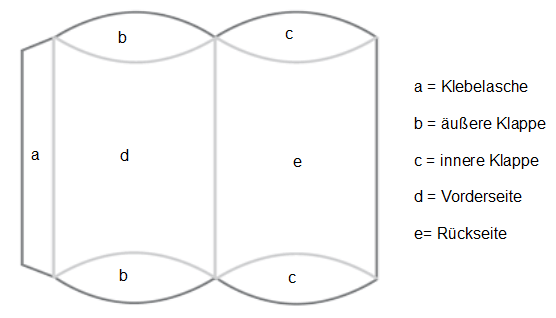 Choose an original, full-surface or matt print and a high-quality finish. We offer you low-cost chromo board (multi-layer board made of waste paper or groundwood with coated, flat surface) for perfect printing results. You can also select the width, height, and depth. We print your pillow boxes in offset flexo printing (CMYK) for rich colours and the best possible print quality. In contrast to conventional printed folding cartons, pillow boxes do not close with tuck-in flaps, but instead have foldable board flaps. These pillow boxes are easy to open and close again and are individually made with your desired motif to hold gifts or promotional items with your logo, slogan, and contact details. In order to guarantee the stability of this type of packaging, we manufacture your individually printed cushion boxes from a sturdy chromo carton. Use our online calculator to create your individual pillow box in the format and size you require for use as gift boxes, advertising material, or industrial packaging and order directly on from reliable printing professionals in business since 1950.
Choose an original, full-surface or matt print and a high-quality finish. We offer you low-cost chromo board (multi-layer board made of waste paper or groundwood with coated, flat surface) for perfect printing results. You can also select the width, height, and depth. We print your pillow boxes in offset flexo printing (CMYK) for rich colours and the best possible print quality. In contrast to conventional printed folding cartons, pillow boxes do not close with tuck-in flaps, but instead have foldable board flaps. These pillow boxes are easy to open and close again and are individually made with your desired motif to hold gifts or promotional items with your logo, slogan, and contact details. In order to guarantee the stability of this type of packaging, we manufacture your individually printed cushion boxes from a sturdy chromo carton. Use our online calculator to create your individual pillow box in the format and size you require for use as gift boxes, advertising material, or industrial packaging and order directly on from reliable printing professionals in business since 1950.2.6 Folding carton with straight tuck end
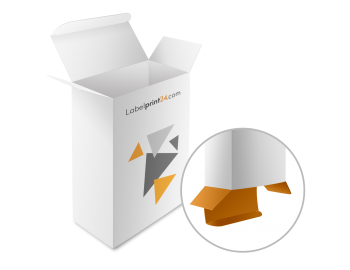
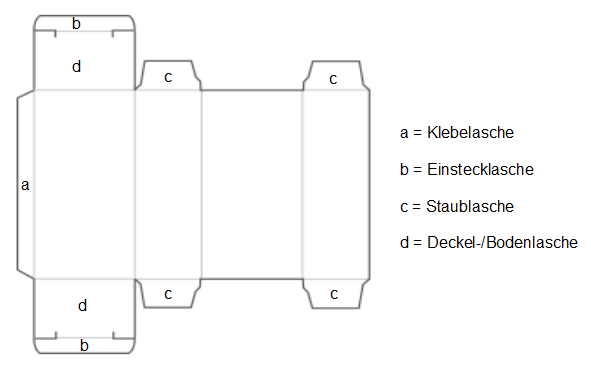
The folding carton with straight tuck end is made from a single piece of board. The long side of the body is glued with the glue flap. The folding carton is securely closed by folding in two dust flaps and a tuck-in flap on both the top and bottom. Typical uses for this type of packaging include packaging for medicines, foodstuffs, computer accessories, or cosmetic products. It protects products from external influences such as dust, moisture, scratches, or light. This packaging is optimal for transport, stacking, and presentation of products.
2.7 Carton slipcase
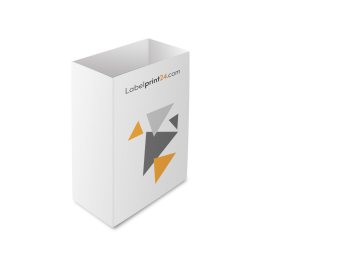
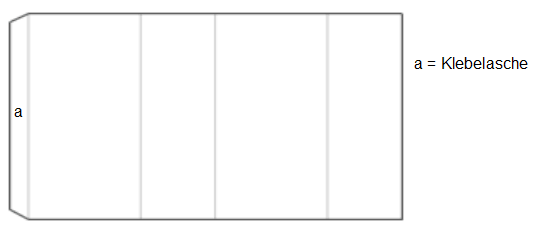
The carton slipcase is an elegant and high-quality packaging solution that makes products look even more valuable and first-class. Due to its robustness, it not only offers a high-quality finish, but also stable protection for the product, which does not suffer any loss of quality when opened and closed multiple times. A slipcase is a carton container closed on four or five sides and open on one or both ends. The internal product is protected, but also given a special refining accent. The carton slipcase also provides a large area for advertising messages or information. The carton slipcase is often used as a classic book slipcase, as gift or advertising packaging, or simply as a cover for a DVD collection.
2.8 Dispenser box for labels
.png)
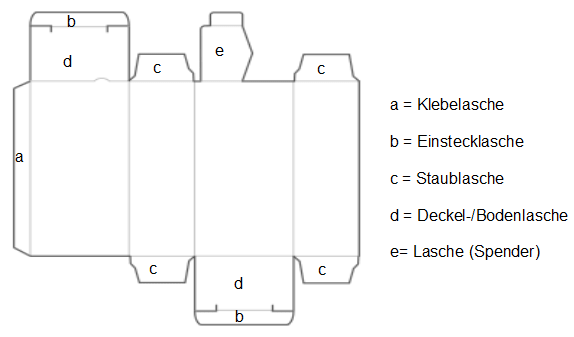
The label dispenser box has flaps that can be tucked in. The roll labels are easy to insert into the dispenser box and can be removed individually by hand. The dispenser box safely stores the labels and protects them from soiling, buckling, or other damage. Due to the folding technique, it is possible to print messages on the dispenser box from all sides. A dispenser box protects roll labels and makes them easy to handle.
2.9 Boxes made to measure - FEFCO
3. Cartons with slip-on lids & hinged-lid boxes
Like our folding cartons, our boxes with tuck-in flaps are punched and glued from only one piece of board. Boxes with slip-on lids, by contrast, consist of two separately produced carton parts: the base and the lid. Both parts must still fit together after filling. The printed slip lid box is delivered flat and then assembled by hand. Slip-on lid boxes are often used to package high-end textiles, such as T-shirts, shirts, ties, or underwear. They are also typical packaging for chocolates, while other foodstuffs tend to be packaged in boxes with hinged lids. Unlike slip-on lids, hinged lids are connected to the base of the box. They are opened from above, not unlike a treasure chest. We have such chocolate boxes in our portfolio.
3.1 Two-piece sliding boxes (matchboxes)
3.2 gable boxes
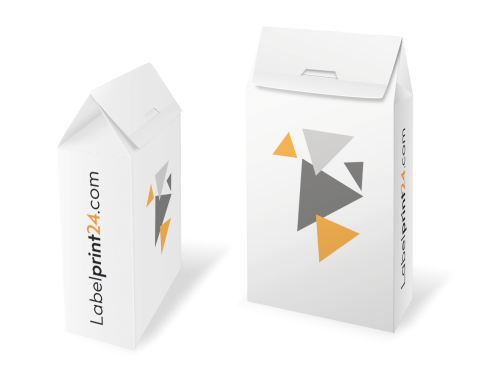
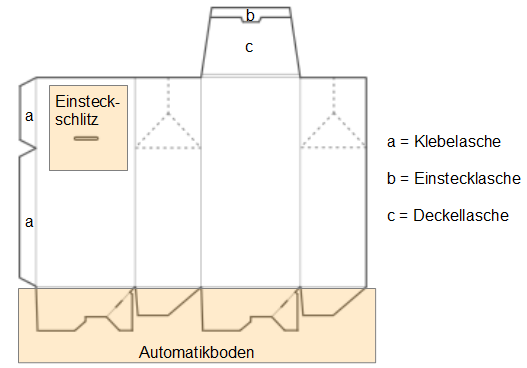
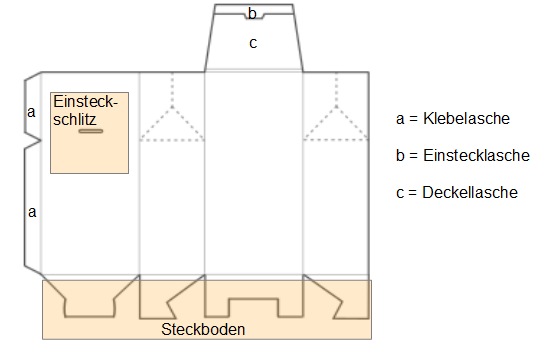
Gable boxes come in a number of different versions and are a refined variant of the classic folding box. Gable boxes are often used to package tea, coffee, spices, or herbs. But they are also ideal for use as packaging gifts, jewellery, confectionery, or giveaways, since they make what's inside seem all the more special. A punched out viewing window or carrying handle will add further to this messaging. A special refinement such as a dispersion coating or blind embossing can further enhance the advertising effectiveness, making the product inside appear even more exclusive and appealing.
Gable boxes with auto bottom are particularly stable and tear-resistant because they are glued. This makes them impermeable and prevents small products from slipping through. The gable box has a rectangular body with pointed, converging sides that form the gable. After filling to the base of the gable, the top is pressed together and closed by inserting the cover flap into the slot on the back. Gable boxes with crash lock bottom also offers a tight closure, but without adhesive. When the box is assembled, the four tabs interlock, making the box quick and easy to fill. The advantage of this variant is that it can also be filled from below.
3.3 Shipping packaging
3.4 Hexagonal boxes
4. Standard formats: determining the right carton size
- the length (l) describes the long side of the opened carton;
- the width (w) describes the short side of the opened carton; and
- the height (h) describes the inner edge from the opening to the base of the carton.
Unless otherwise stated, the dimensions of paperboard folding cartons are always given as internal dimensions (from crease to crease) and in mm units.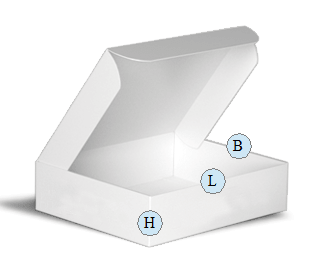
DIN format boxes
Overview of DIN packaging
| DIN A format. | Printed matter, miscellaneous |
| DIN C format | Envelopes mainly suitable for DIN A format paper |
| DIN B format | Larger and suitable for shipping in DIN C format paper |
| DIN | Size (mm) | DIN | Size (mm) | DIN | Size (mm) |
|---|---|---|---|---|---|
| A0 | 841 × 1189 | B0 | 1000 × 1414 | C0 | 917 × 1297 |
| A1 | 594 x 841 | B1 | 707 × 1000 | C1 | 648 × 917 |
| A2 | 420 x 594 | B2 | 500 × 707 | C2 | 458 × 648 |
| A3 | 297 x 420 | B3 | 353 × 500 | C3 | 324 × 458 |
| A4 | 210 x 297 | B4 | 250 × 353 | C4 | 229 × 324 |
| A5 | 148 x 210 | B5 | 176 × 250 | C5 | 162 × 229 |
| A6 | 105 x 148 | B6 | 125 × 176 | C6 | 114 × 162 |
| A7 | 74 x 105 | B7 | 88 × 125 | C7 | 81 × 114 |
| A8 | 52 x 74 | B8 | 62 × 88 | C8 | 57 × 81 |
| A9 | 37 x 52 | B9 | 44 × 62 | C9 | 40 × 57 |
| A10 | 26 x 37 | B10 | 31 × 44 | C10 | 28 × 40 |
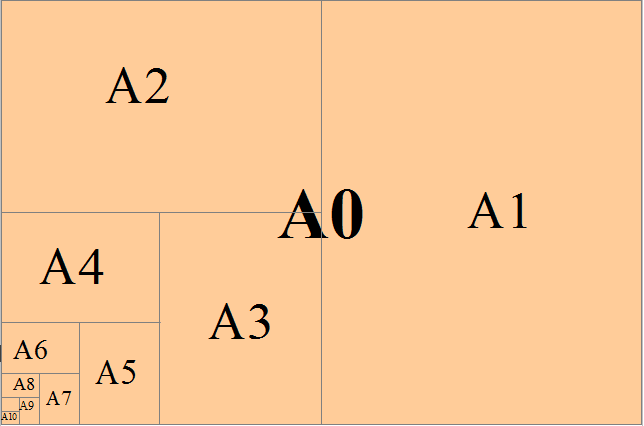
Also discover

